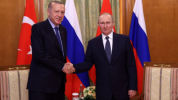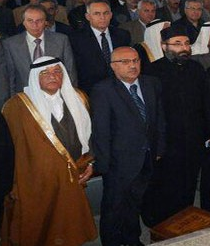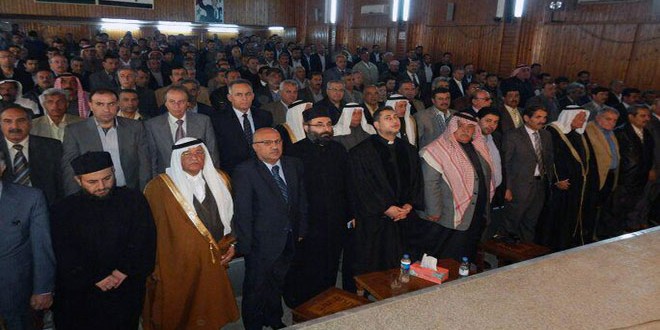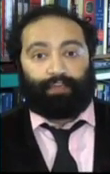Putin’s Syrian peace plan with Erdogan
 Russian President Vladmir Putin and Turkish President Recep Erdogan held a four-hour meeting on August 5 in Sochi which may change the course of the Middle East, and end the US occupation of Syria.
Russian President Vladmir Putin and Turkish President Recep Erdogan held a four-hour meeting on August 5 in Sochi which may change the course of the Middle East, and end the US occupation of Syria.
 Russian President Vladmir Putin and Turkish President Recep Erdogan held a four-hour meeting on August 5 in Sochi which may change the course of the Middle East, and end the US occupation of Syria.
Russian President Vladmir Putin and Turkish President Recep Erdogan held a four-hour meeting on August 5 in Sochi which may change the course of the Middle East, and end the US occupation of Syria.
Last month, US secretary of State John Kerry called for Syria to be partitioned saying it was "Plan B" if negotiations fail. But in reality this was always plan A. Plans to balkanize Syria, Iraq and other Middle Eastern states were laid out by former U.S. Secretary of State Condoleezza Rice in a 2006 trip to Tel Aviv. It was part of the so called "Project For a New Middle East". This was a carbon copy of the Odid Yinon plan drawn up by Israel in 1982. The plan outlined the way in which Middle Eastern countries could be balkanized along sectarian lines. This would result in the creation of several weak landlocked micro-states that would be in perpetual war with each other and never united enough to resist Israeli expansionism.
"Syria will fall apart, in accordance with its ethnic and religious structure, into several states such as in present day Lebanon, so that there will be a Shi'ite Alawi state along its coast, a Sunni state in the Aleppo area, another Sunni state in Damascus hostile to its northern neighbor, and the Druzes who will set up a state, maybe even in our Golan… " Oded Yinon, "A strategy for Israel in the Nineteen Eighties",
The leaked emails of US Secretary of State Hillary Clinton reveal advocates of the Oded Yinon plan were behind the US push for regime change in Syria. An Israeli intelligence adviser writes in an email to Hillary,
"The fall of the House of Assad could well ignite a sectarian war between the Shiites and the majority Sunnis of the region drawing in Iran, which, in the view of Israeli commanders would not be a bad thing for Israel and its Western allies,".
Kerry's plan B comment came right before UN's special envoy de Mistura said federalism would be discussed at the Geneva talks due to a push from major powers. Both side's of the Geneva talks, the Syrian Government and the Syrian National Coalition flat out rejected Federalism. Highlighting the fact that the idea did not come from the Syrian's themselves. The Syrian ambassador to the United Nations, Bashar Al Jaafari, said that the Idea of federalization would not be up for discussion. "Take the idea of separating Syrian land out of your mind," he would say.
But some may not completely understand the full implications of federalism and how it is intrinsically tied to balkanization. Some cite the fact that Russia and the United States are successful federations as evidence that federation is nothing to fear. However the point that makes these federalism statements so dangerous is that in accordance with the Yinon plan the borders of a federalized Syria would be drawn along sectarian lines not on whether any particular state can sustain its population. This means that a small amount of people will get all the resources, and the rest of Syria's population will be left to starve. Furthermore, Russia and the US are by land mass some of the largest nations in the world, so federalism may make sense for them. In contrast Syria is a very small state with limited resources. Unlike the US and Russia, Syria is located in the Middle East which means water is limited. In spite of the fact Syria is in the so-called fertile crescent, Syria has suffered massive droughts since Turkey dammed the rivers flowing into Syria and Iraq. Syria's water resources must be rationed amongst its 23 million people. In the Middle East, wars are also fought over water.The areas that the Yinon plan intends to carve out of Syria, are the coastal areas of Latakia and the region of Al Hasake. These are areas where a substantial amount of Syria's water, agriculture and oil are located. The intention is to leave the majority of the Syrian population in a landlocked starving rump state, and create a situation where perpetual war between divided Syrians is inevitable. Ironically promoters of the Yinon plan try and paint federalism as a road to peace. However, Iraq which was pushed into federalism in 2005 by the US occupation is far from peaceful now.
Quite simply, divide and conquer is the plan. This was even explicitly suggested in the headline of Foreign Policy magazine, "Divide and conquer Iraq and Syria" with the subheading "Why the West Should Plan for a Partition". The CEO of Foreign Policy magazine David Rothkopf is a member of to the Council of Foreign Relations, a think tank Hillary Clinton has admits she bases her policies on. Another article by Foreign Policy written by an ex-NATO commander James Stavridis, claims "It's time to talk about partitioning Syria".
The US hoped to achieve this by empowering the Muslim Brotherhood and other extremist groups, and introducing Al Qaeda and ISIS into Syria. The Syrian army was supposed to collapse with soldiers returning to their respective demographic enclaves. Evidence of this could be seen in the headlines of NATO's media arm in 2012, which spread false rumours that Assad had run to Latakia, abandoning his post in Damascus. The extremists were then supposed to attack Alawite, Christian and Druze villages. The US hoped that enough Alawites, Christians and Druze would be slaughtered that Syria's minorities would become receptive to the idea of partitioning.
Then NATO planned on shifting narratives from, "evil dictator must be stopped" to "we must protect the minorities". Turning on the very terrorists they created and backing secessionist movements. There is evidence that this narrative shift had already started to happened by 2014 when it was used to convince the US public to accept US intervention in Syria against ISIS. The US designation of Jabhat Al Nusra as a terrorist organisation in December of 2012 was in preparation for this narrative shift. But this was premature as none of these plans seemed to unfold according to schedule. Assad did not leave Damascus, the Syrian army held together, and Syrian society held onto its national identity.
It could be said that the Yinon plan had some success with the Kurdish PYD declaration of federalization. However, the Kurdish faction of the Syrian national coalition condemned PYD's declaration. Regardless, the declaration has no legal legitimacy. The region of Al Hasakah where a substantial portion of Syria's oil and agriculture lies, has a population of only 1.5 million people, 6% of Syria's total population. Of that, 1.5 million, only 40% are Kurdish, many of which do not carry Syrian passports. PYD's demand that the oil and water resources of 23 million people be given to a tiny part of its population is unlikely to garner much support amongst the bulk of Syria's population.
Former US National Security Adviser Henry Kissinger understood that the key to dismembering a nation was attacking its national identity. This entails attacking the history from which this identity is based upon. In an event at Michigan University Kissinger stated that he would like to see Syria balkanized, asserting that Syria is not a historic state and is nothing but an invention of the Sykes-Picot agreement in the 1920's. Interestingly, Kissinger is using the same narrative as ISIS, who also claims that Syria is a colonial construct. In fact, ISIS has been a key tool for Kissinger and the promoters of the project of a New Middle East, as ISIS has waged a campaign of destruction against both Syrian and Iraqi historical sites.
In spite of efforts to convince the world of the contrary, the region that now encompasses modern day Syria has been called Syria since 605 BC . Sykes-Picot didn't draw the borders of Syria too large, but instead, too small. Historical Syria also included Lebanon and Iskandaron. Syria and Lebanon were moving towards reunification until 2005, an attempt at correcting what was a sectarian partition caused by the French mandate. Syria has a long history of opposing attempts of divide and conquer, initially the French mandate aimed to divide Syria into 6 separate states based on sectarian lines, but such plans were foiled by Syrian patriots. The architects of the Yinon plan need only have read Syria's long history of resistance against colonial divisions to know their plans in Syria were doomed to failure.
See also Assembly of Syrian Tribes and Clans in Hasaka reject so-called “federal region in Northern Syria”, previously published (19/3/16) on SANA. This article by Maram Susli was previously published on New Eastern Outlook. Maram Susli, also known as "Syrian Girl," is an activist-journalist and social commentator covering Syria and the wider topic of geopolitics. especially for the online magazine "New Eastern Outlook."

Previously published (19/3/16) on the Syrian Arab News Agency (SANA)
See also;Kurdish “Federalization” Reminiscent Of Kerry’s Plan B, Brzezinski, NATO Plan A (17/9/16) | Global Research by Barndon Turbeville, also published (18/3/16) on Activist Post.
Damascus, SANA – The Assembly of Syrian Tribes and Clans in Hasaka province stressed its firm rejection of the declaration of the so-called “federal region in northern Syria,” adding that such an attempt to undermine Syria’s sovereignty is doomed to failure.
The Assembly pointed out that the timing of this declaration came as a reaction to the exclusion of Kurds from dialogue in Geneva, stressing that the Kurds constitute an important component of the Syrian society that cannot be excluded from the process of shaping the country’s future.
The statement noted that no party has the right to tamper with the form of state and its political system in a unilateral way and in an uncalculated, reaction manner, since such behavior constitutes a flagrant threat to the unity of the Syrian people and geography.
The Assembly said that the self-administration experience, even if it hides behind claims of democracy, is a reflection of the will of a singular component and constitutes an attempt to force others to comply with this will in order to impose a fait accompli.

The statement affirmed that declaration of the so-called “federal region in northern Syria” doesn’t express the will of millions of Syrians who stand by the Syrian Arab Army in its fight against terrorism to restore security and stability to the country.
The Assembly stressed that Syria’s future, form of state, and system of government cannot be subject to whims and short-sighted calculations, rather they are decided by the Syrian people, defined according to constitution, and protected by the will of the people and international laws.
The participants reiterated their rejection of any plot which undermines Syria’s unity, stressing that the residents of Hasaka province are united and will not permit any foreign schemes to pass.
They also called for enhancing national unity, adhering to Syria’s territorial integrity, rejecting federation, and intensifying efforts to combat terrorism and foil the conspiracy targeting Syria.
Story 1 includes video (9:50).
See also:
People of Ayn al-Arab regain control of cultural center and 48th Street (17/10/14) and People of Ayn al-Arab repel new ISIS assault, recapture more areas (18/10/14) from SANA and Mythology and The Islamist State (18/10/14) by William Blum on Global Research.
Update, 17 Oct 14: from Syrian Free Press and RT: Kurdish forces repel Daash-ISIL mercenaries from Kobani. See Appendix.
 |
In an interview, conducted with Press TV on October 15, 2014 Mahdi Darius Nazemroaya explains in the reasons behind the ISIL (also known as ISIS) attack on the Syrian town of Kobani (Ain al-Arab) in the Syrian Kurdish autonomous region. Mahdi shows that the supposed campaign of bombardment against ISIS is illusory, with few bombs being dropped on ISIS fighters and far more being dropped on Syrian infrastructure. Turkey, whilst pretending to oppose ISIS is supporting ISIS against the Syrian Kurds to the point of provoking mass unrest against the Turkish government in which 40 Turkish Kurds have died. |
 Female Kurdish fighter
featured in the film |
Towards the end of the video, although the fighting around Kobani looks grim in many ways, Mahdi reminds us that Syria has many friends in the world. As well as people of good will in the West, there are the governments of Iran, Russia, Belarus, Kazakhstan, many Latin American countries and the resistance movement,
1.↑ Previously published on Global Research as Nazemroaya: Crushing Kobani's Kurds is a Prerequisite to an Invasion of Syria. This was apparently only published on the front page of Global Research. Unlike other stories published on Global Research, this story does not seem to appear on a separate page. The YouTube page is here. - Ed.
Recent comments